|
Books by
Jeffery Robenalt
|
|
|
In
1846, at the dawn of the war with Mexico, the United States Army
had no cavalry branch, but instead relied on mounted infantry called
dragoons. Although dragoons rode to battle, they were trained to
dismount and fight as infantry. Unfortunately, these troops were
too heavy and cumbersome to perform the normal tasks assigned to
cavalry such as scouting enemy territory, screening the army’s movements,
and swiftly delivering important dispatches. Prior to the initiation
of hostilities, Major Jack Hays met with General Zachary Taylor
in Corpus
Christi and offered the services of his Texas Rangers to fill
this critical void.
Far from well-versed in the use and tactics of cavalry, and confident
that his dragoons would prove satisfactory, General Taylor refused
Hays' offer. Besides, as far as Taylor was concerned, the Texans
were irregulars, not proper soldiers. While it was true the Rangers
could fight like pure devils, they occasionally behaved like wild
men. However, devils or not, Taylor soon changed his mind when he
moved his army south into the Nueces Strip and found that his dragoons
were no match for the well-mounted and highly mobile Mexican cavalry.
|
|
|
Zachary
Taylor Daguerreotype
Wikimedia Commons |
|
After Mexican
General Arista’s cavalry captured 60 dragoons without a fight, General
Taylor asked Jack Hays for the services of Sam
Walker and a few other Texas Rangers to keep his lines of communication
open between Port
Isabel and Fort Brown on the Rio Grande. While successfully
accomplishing this mission, Walker
and his men discovered that Arista was moving his forces into a
position north of the river to ambush the American advance. The
Rangers then made a daring night ride through the Mexican lines,
warning Taylor in time to avoid the potential disaster and help
set up the subsequent American victories at Palo Alto and Reseca
de la Palma.
In response to the early victories, President James K. Polk asked
the United States Congress for a declaration of war, and General
Taylor requested that the governor of Texas, James
Pinkney Henderson, raise a regiment of Texas Rangers for service
in Mexico. The Rangers began to filter down to the Rio Grande company
by company, as soon as they had been mustered in; the first being
those commanded by Ben McCulloch and Ad Gillespie. Unlike most of
the men in Taylor's army, the Rangers who made up these companies
were frontiersman of the first order, not young, inexperienced farm
boys in search of adventure. In fact, it was generally held that
McCulloch’s company was one of the finest ever assembled in the
ranging service.
As soon as McCulloch’s Rangers were encamped near Fort Brown, General
Taylor ordered them to conduct a scout of the ground between Matamoros
and Monterrey with the purpose of selecting the best route for the
upcoming invasion. The patrol rode into Mexico on June 12, and quickly
determined that the road to Monterrey through Linares was unsuitable
for use as an invasion route due to a lack of water. After spending
ten days deep in enemy territory and riding nearly 250 miles without
removing their boots or spurs, the Rangers returned with word that
the best invasion route lay through Cerralvo and the San Juan River
valley.
|
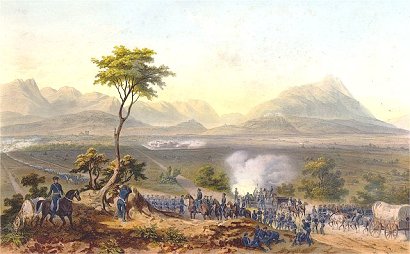 |
US
troops marching on Monterrey
Painting by Carl Nebel
Wikimedia Commons |
|
On July 9, General
Taylor marched his army to Camargo in preparation for the advance
on Monterrey. Following the occupation of Camargo, Taylor maneuvered
his forces for the long-anticipated attack on Monterrey, by first
capturing Mier, and then advancing toward Cerralvo on the western
slope of the San Juan valley. Acting as the eyes and ears of the
army during the advance required McCulloch’s Rangers to practically
live in the saddle. In addition to their scouting duties, the Rangers
aided Taylor’s forces by delivering important dispatches and suppressing
local guerilla activity, thus protecting the army’s thinly-stretched
supply lines.
By September 12, Taylor’s main force was encamped at Cerralvo, poised
to strike at Monterrey. Newly elected Colonel Jack Hays and the
remainder of the Ranger regiment were encamped just across the San
Juan River from Taylor at the small Mexican town of China. On the
following morning, both columns marched south and joined up four
days later at the little town of San Francisco, within view of the
mountains that stood like rigid sentinels astride the northern approach
to Monterrey.
Early the next afternoon, the reconstituted Ranger regiment, accompanied
by General Taylor and his staff, were the first troops to reach
the long slope overlooking picturesque Monterrey, some three miles
in the distance. Taylor ordered the army to encamp at a beautiful
spring-fed grove of live oak and pecan trees that served as the
fashionable city’s picnic ground — the troops dubbed it Walnut
Springs — and began a careful study of Monterrey’s defenses.
To the northeast of the city stood the Citadel, a formidable walled
fortress surrounded by a moat and protected by cannons. The Santa
Catrina River and a chain of rugged mountains covered the southern
approach, and guarding the Saltillo Road to the west of Monterey
were two steep, fortified hills, Federation and Independence.
The plan devised by General Taylor called for two regiments of General
William Worth's 2nd Brigade, reinforced by Hays’ Rangers, to march
around to the west of the city. Worth was responsible for securing
both Federation and Independence hills before launching an assault
on the western quadrant of the city. In conjunction with Worth’s
attack, Taylor would make a diversionary assault on the well-defended
eastern quadrant of the city with his main force of regulars.
|
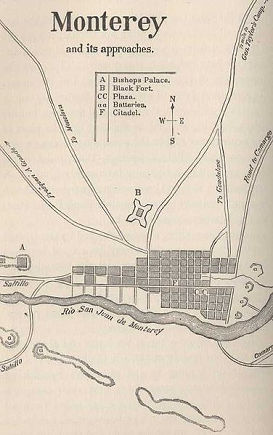 |
Map of Monterrey's
defences
Illustration from the "Personal Memoirs of General U. S. Grant — Complete
by Ulysses S. Grant".
Wikipedia |
Gen.
Worth's division marches on Monterrey from the west, 1846
Wikimedia Commons |
|
The battle for
Monterrey officially began early in the morning of 21 September,
after a night of cold rain and little sleep, when General Worth’s
marching column was struck just west of Independence Hill by a regiment
of Mexican lancers. McCulloch’s Rangers, riding at the head of the
column, immediately dismounted and took cover behind a split-rail
fence overgrown with brush and cactus. Using their rapid-firing
Colt revolvers and deadly muzzle-loading shotguns to good advantage,
the Rangers broke the fury of the charge and drove the Mexicans
back. Before the shattered ranks of lancers could regroup, a battery
of American 6-pounders wheeled into place, unlimbered their guns,
and began to target the massed horsemen with highly accurate canister
rounds. The Mexicans were forced to withdraw with heavy losses.
As the Americans resumed their march, Worth’s column was brought
under heavy fire from Mexican artillery batteries posted on Federation
Hill. Although the barrage caused few casualties, General Worth
was convinced that the guns on both hills would have to be silenced
before he launched his attack on Monterrey. His first objective
would be Federation Hill, and then the higher and even more heavily
defended Independence Hill. The attack on Federation Hill would
be led by 300 Texas Rangers, who would storm the hill on foot supported
by the 5th and 7th Infantry regiments, a total of 860 men.
The assault force boldly forded the Santa Catarina River and moved
into position to launch the attack. The western face of Federation
Hill was steep, offering little cover, and the Texas Rangers and
infantry were forced to make the treacherous climb directly into
the face of enemy artillery fire and the muskets of 500 Mexican
soldiers manning the earthworks dug in just below the crest of the
hill. The only salvation of the attackers was to move quickly. Any
hesitation would simply add to the carnage. Screaming their defiance,
the Rangers stormed the hill.
The fury of the Texan charge drew the focus of the Mexicans’ attention
and their heaviest fire, allowing the infantry to advance with little
interference. When the 5th infantry crested the hill on the northern
flank of the earthworks, lowered bayonets flashing in the sun, the
Mexican line crumbled and fell back on Fort Salado at the opposite
end of the hill. The retreat quickly turned into a rout, as the
Mexicans abandoned their artillery pieces and fled from the wrath
of the Diablos Tejanos.
Without pausing to catch their breath, the Texans raced after the
fleeing Mexicans, while the American infantry turned the captured
artillery pieces and brought the enemy under fire with their own
guns. Refusing to give the Mexicans an opportunity to regroup, the
Rangers of Ad Gillespie's company pursued them up and over the earthen
walls of Fort Salado. Faced with this terrible onslaught, the Mexicans,
who had not yet been killed or captured, abandoned the fort and
fled across the Santa Catarina River to the safety of nearby Independence
Hill.
Meanwhile, General Taylor’s diversion in the east had failed to
meet with the same success. The attack had begun with an attempt
to flank a Mexican fort located on a high hill in northeast Monterrey.
The Americans stormed straight down the narrow streets, directly
into the intense fire of Mexican soldiers concealed on barricades,
fortified rooftops, and second story windows. To make matters worse,
the smoothbore muskets of the regular army were not accurate enough
to suppress the fire of the well-hidden Mexicans, and the American
artillery shells could not penetrate the walls of the stout adobe
and stone buildings. Taylor’s infantry was forced to withdraw with
heavy casualties.
|
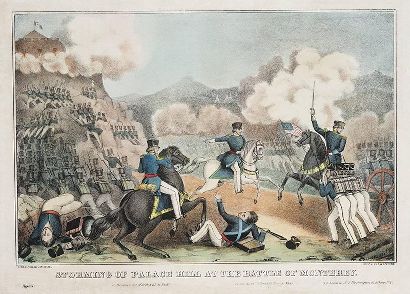 |
Storming
of Palace Hill at the Battle of Monterrey
lithograph by Tompkins Harrison Matteson, c. 1855
Wikimedia Commons |
On
September 22, all the action took place on General Worth’s western
front. Throughout the previous night, American artillery firing from
Federation Hill had dueled with the Mexican guns on Independence Hill,
but now the hill would have to be captured. On the eastern end of
Independence Hill, nearest Monterey, stood the Bishop’s Palace, a
stone, castle-like fortress bristling with cannon that was the key
to the city’s western defenses. On the western end of the hill, the
Mexicans had constructed an earthen fortification, Fort Libertad,
to command the approach from the Saltillo Road. The fortification
was manned with infantry and three batteries of artillery.
From Fort Libertad, the western face of Independence Hill plunged
steeply for eight hundred feet through rugged, rock-strewn terrain;
an approach so formidable the Mexicans did not even bother to post
sentries. However, in spite of the difficult terrain, Jack Hays convinced
General Worth that the Mexicans could be taken by surprise. The assault
force totaled 200 Texas Rangers supported by 300 infantry. Worth’s
plan called for a coordinated attack by two separate columns. One,
led by Ad Gillespie’s company, climbed the southwest face of the hill
under the command of Sam
Walker. The other, led by Ben McCulloch’s Rangers, tackled the
even more imposing northwest face under the command of Jack Hays.
The two columns would unite just below the summit of the hill and
make the final attack together.
The perilous climb began at 3:00 A.M. on 22 September, after a long
night of thunderstorms left the jagged rocks on the cliff wet and
slippery. In spite of a stiff, cold wind that continued to blow out
of the west, the Rangers climbed to within 100 yards of the summit
before they were spotted. Caught completely off guard, the Mexicans
failed to react in time, and after firing a fierce volley, the Texans
once again led the way in a screaming charge. The Mexican defense
collapsed and the terrified soldados fled for the safety of the Bishop’s
Palace. American casualties were light, but much to the Rangers’ sorrow,
Ad Gillespie was killed by the thrust of a Mexican bayonet.
At the urging of Colonel Hays, General Worth then advanced a company
of Louisiana dragoons toward the Bishop’s Palace where they fired
a volley before feigning a hasty retreat. The ruse worked, as the
Mexicans poured out of the Palace in pursuit of the retreating dragoons
only to crest a rise in the mesa and come face-to-face with the 5th
and 7th Infantry regiments. The American infantry fired a well-coordinated
volley before advancing with lowered bayonets, and the Rangers added
to the confusion by opening fire on the exposed Mexican flanks from
concealed positions along both sides of the hill.
Pressing their advantage, the American infantry and Rangers quickly
turned the Mexican retreat into another rout. A group of artillerymen
who had hoisted a 12-pound howitzer up the steep face of the western
slope added to the carnage by battering the gates of the palace with
round after round of solid shot, and the remaining defenders fled
toward the city. Worth spent the rest of the day consolidating his
position and moving his forces into the western outskirts of Monterrey.
Early the following morning, 23 September, the American assault on
Monterrey began with coordinated attacks from the west and east. This
time, however, instead of attacking directly down the narrow streets,
the Americans employed new urban warfare techniques taught to them
by the Texas Rangers. The Texans had gained experience fighting in
Mexican-style cities during the siege
of San Antonio in 1835 and again in 1842
at the infamous border town of Mier. Both towns were constructed
similar to Monterrey, with narrow streets, a central square, and thick-walled
buildings with shared interior walls and parapets lining their flat
roofs.
From the bloody street fighting
in San Antonio and Mier,
the Texans had learned to “mouse hole” from house-to-house by using
battering rams, picks, sledge hammers, and occasionally explosives,
to smash through shared walls and bypass enemy strong-points. Once
inside a building, they would systematically work their way to the
roof and clear it before continuing their advance to the next building.
The process was tedious and time consuming, but it resulted in far
fewer casualties. The Texans had also learned not to approach street
barricades head-on, especially if they were fortified with artillery.
Instead, once cleared, they would place their own snipers on the rooftops
to kill any artillerymen foolish enough to approach the guns.
The Texans and Mississippians fighting under Jefferson Davis in the
east also possessed rifles rather than smoothbore muskets. The barrels
of these weapons were rifled which spun the bullet as it exited from
the muzzle, making them much more accurate than standard issue muskets.
The rifles allowed the Texans and Mississippians to hit the well-hidden
Mexican soldiers, who rarely showed more than their head above a parapet
or a glimpse at a window or hole in a wall. Unfortunately, although
many of the techniques employed at Monterrey are still used in urban
warfare today, the lessons were not retained by the U.S. Army of 1846
and had to be relearned later. |
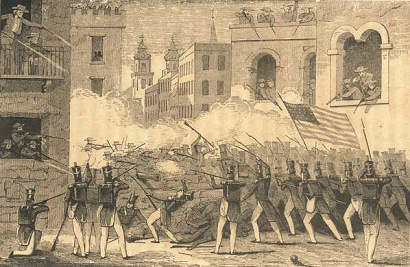 |
Battle
of Monterrey
Wikipedia |
| Under intense
pressure from the American assault, Mexican troops grudgingly abandoned
their well-fortified positions and slowly withdrew toward the center
of the city. Eventually, they were trapped in the area of the central
plaza and cathedral, along with the civilians who had remained in
Monterrey, where they suffered under a nearly continual bombardment
from the deadly American howitzers. General Ampudia soon determined
that his only course of action was to negotiate, and surprisingly,
General Taylor not only agreed, but also granted liberal terms. In
exchange for a two month armistice, the Mexican army surrendered Monterrey,
but was permitted to withdraw from the city with their arms intact.
|
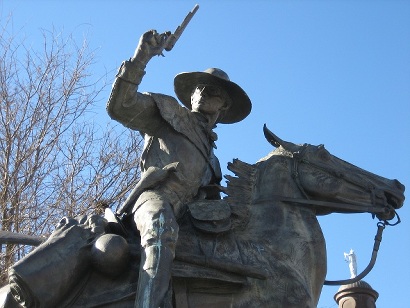 |
As for the Texas
Rangers, who had contributed much to the effort at Monterrey, and
felt as if a hard-earned victory had been snatched from their grasp,
Taylor’s decision to accept an armistice was a bitter pill to swallow.
After years of struggle with Mexican incursions and atrocities, such
as the slaughter at the Alamo
and the merciless executions at Goliad
and Mier, the
Rangers were forced to stand by and watch as the Mexican army marched
away. However, General Worth was more than appreciative of the Rangers’
sacrifice, and had much to say of “the distinguished gallantry of
Colonel Hays and his noble band of volunteers. Hereafter they and
we are brothers, and we can desire no better security of success than
by their association.”
The Texans were not alone in their disappointment with Taylor’s armistice.
A furious President Polk insisted that General Taylor and the U.S.
Army had no authority to negotiate an armistice with the enemy, “only
to kill them.” Most government observers also agreed that allowing
the Mexicans to retreat with full battle honors and all their weapons
was pure folly. Polk would now shift the focus of the war to General
Winfield Scott and the invasion of Vera Cruz, where Jack Hays and
the Texas Rangers would once again play a key role in the American
effort.
© Jeffery
Robenalt
"A Glimpse of Texas Past"
September
3, 2012 Column
jeffrobenalt@yahoo.com
References
› |
References
for "Texas Rangers at the Battle of Monterrey"
|
|
Carney, Stephen
A. (2005), Gateway South: The Campaign for Monterrey, Department
of the Army, ISBN 978-0160723742.
Clary, David
A. (2009), Eagles and Empire: The United States, Mexico, and
the Struggle for a Continent, Bantam Press, ISBN 0553806521.
Davis, Joe
Tom (1989), Legendary Texans, Vol. IV, Eakin Press, Austin,
TX, ISBN 0-89015-669-7.
Dishman, Christopher
(2010), A Perfect Gibraltar: The Battle of Monterrey, Mexico,
University of Oklahoma Press, ISBN 0-8061-4140-9.
Eisenhower,
John S.D. (1989), So Far from God, The U.S. War with Mexico,
1846-1848, Random House, ISBN 978-0-8061-3279-2.
Fehrenbach,
T.R. (1968), Lone Star: A History of Texas and the Texans,
Macmillan Publishing Company, NY, ISBN 0-02-032170-8.
Henderson,
Timothy J. (2008), A Glorious Defeat: Mexico and Its War with
the United States, Farrar, Straus and Giroux, ISBN 0809049678.
Hudgison, Chris
(2009), The Battle of Monterrey: Urban Operations during the
Mexican War, Infantry Magazine, March-June 2009, www.findarticles.com/p/articles/mi_mOIV/is_2_98/ai_n35625551.
A Continent
Divided: The U.S.- Mexico War, www.library.uta.edu/usmexicowar.
|
|
|
